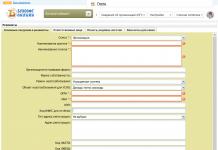At the end of the twentieth century. V developed countries A new scientific and practical direction has emerged - risk management of various spheres of human activity. The influence of random events (risks) causing physical, moral and economic damage to the health of patients is being explored in a new direction for the system of protecting and restoring public health - risk management in healthcare.
In general terms risk- this is an event or a group of related random events that cause damage to an object that has a given risk.
Randomness, or the unpredictability of the occurrence of an event, means the impossibility of accurately determining the time and place of its occurrence.
Risk management (risk management)- this is a system of measures the purpose of which is to reduce the damaging or destructive impact of a hazard on the health, life, property, financial situation of the person at risk, etc.
The priority of risk management in medicine is to manage the quality of the diagnostic and treatment process and thereby ensure the medical safety of the patient.
Currently offered the following classification of patient risks:
1. Socio-political risks:
o changes in legislation on forms and methods of organization medical care to the population
o making changes to the health care financing system
o development of new economic relations and health management methods
o introduction and reorganization of the health insurance system
o privatization or nationalization of healthcare entities
o innovation processes in improving legal framework healthcare (new organizational and legal forms of activity of medical organizations, entrepreneurship in healthcare, protection of patients’ rights, professional insurance medical activities and etc.)
o amendments to arbitration law
2. Risks associated with management:
o lack of a system of basic training of specialists in the field of health care management and economics, medical law
o incompetence of managers in the field of management, economics and legislation in healthcare
o low professional level certain part of the staff
o scientifically unfounded choice of industry reform strategy
o neglect of occupational health and safety activities
3. Professional (medical) risks associated with civil liability:
o diagnostic
o medicinal
o medicinal (pharmacotherapeutic)
o preventive
o infectious
o psychogenic (psycho-emotional)
4. Health risks medical workers from the side:
o patients with particularly dangerous infections
o patients with viral hepatitis B and C, HIV infection, syphilis and other sexually transmitted diseases
o patients with tuberculosis
o mental patients
o drug addicts
o criminals who attack medical personnel in order to obtain narcotic drugs
5. Other risks:
o technogenic (technical and operational)
o fire hazardous
o explosive (storage and operation of oxygen)
o terrorist
In accordance with the proposed Classification of Risks in Healthcare, we will analyze patient safety problems in the most vital situations of medical practice.
Medical errors can be made at all stages of the relationship with the patient. The greatest dangers lie in diagnostic errors.
Sonis A. G. 1 , Gilmiyarov E. M. 2 , Dodonov A. G. 3 , Alekseev D. G. 4 , Gryzunov T. E. 5
3 Candidate of Medical Sciences,
4 Candidate of Medical Sciences, Associate Professor,
5 Applicant,
1,2,3,4,5 Samara State Medical University
RISK MANAGEMENT IN CLINICAL EXPERT WORK ON THE EXAMPLE OF DENTAL CARE IN CLINICS OF SAMARA STATE MEDICAL UNIVERSITY
annotation
The article presents the experience of introducing the ISO 9001-2015 Quality Management System standard into clinical expert work using the example of dental care provided at the Clinics of Samara State Medical University. The content of the concepts risk, risk-oriented thinking and risk management in medical organization. By analyzing the design of 400 medical records of dental patients, risks arising during the provision of dental care were identified, and an analysis of their possible consequences was carried out. Methods for managing identified risks have been selected to help reduce the likelihood of adverse consequences and corresponding losses.
Keywords: quality management system, ISO standard, dental care, risk, risk management, consequences.
Sonis A. G. 1 , Guilmiyarov E. M. 2 , Dodonov A. G. 3 , Alekseev D. G. 4 , Gryzunova THOSE. 5
1 MD, Professor,
2 MD, Professor,
4 MD, Associate professor,
5 Postgraduate student,
RISK MANAGEMENT IN CLINICAL AND EXPERT WORK ON EXAMPLE OF DENTAL CARE IN CLINICS OF SAMARA STATE MEDICAL UNIVERSITY
Abstract
The article presents the experience of introduction of ISO quality management system 9001-2015 in the clinical and expert work on the example of dental care provided by the Clinics of the Samara State Medical University. The contents of the concepts of a risk, a risk-oriented thinking and a risk management in a medical organization are disclosed. By analyzing the registration of 400 medical records of dental patients, the risks associated with the provision of dental care were identified, and the analysis of their possible consequences was carried out. The managing methods for the identified risks were chosen, which contribute to reducing the likelihood of adverse consequences and corresponding losses.
Keywords: quality management system, ISO standard, dental care, risk, risk management, consequences.
In a medical organization, to meet the needs of patients, it is necessary to follow the developed standards of the Quality Management System. The latest version of ISO 9001, the optimal example of the Quality Management System standard, was approved on September 28, 2015 by Rosstandart Order No. 1391-st “On approval of the national standard” (hereinafter referred to as ISO 9001-2015 standard). The ISO 9001-2015 standard “Quality management systems. Requirements" introduced the concept of risk-oriented thinking, which allows the organization to identify factors that can lead to deviations from the planned results of the quality management system, as well as to use preventive controls to minimize negative consequences, that is, manage risks.
Risk management is the process of making and implementing management decisions aimed at reducing the likelihood of an unfavorable outcome and minimizing possible losses.
Currently, there is no single, standardized definition of the concept of “risk” in relation to medical and clinical expert work. In this regard, risk management is quite difficult. Therefore, before considering the features of risk management procedures, it is necessary to determine exactly what we mean by “risk” in a medical organization. In accordance with the modern approach to the category of risk in economics, risk in the work of a medical organization can be considered the probability of negative consequences arising as a result of medical activities.
Applicable to medicine, there are two types of risk: systematic and unsystematic. Systematic risks relate to external factors and are beyond the general control of a medical organization, for example, the state of healthcare financing in the country. These factors must be considered and taken into account, because the medical organization is not able to influence their change. Unsystematic risks are something that directly affects a medical organization. These risks may be associated with the process of providing medical care: diagnostic, therapeutic, rehabilitation; or associated with auxiliary processes: feeding patients, cleaning the institution, etc. These risks can be controlled or influenced within the organization.
According to the degree of impact on the patient’s health, risks can be divided into: acceptable (without causing harm to health), critical (deterioration of health) and catastrophic (disability or death). If it is possible to eliminate them, risks are divided into non-diversified (not subject to elimination) and diversified (for which there are possible ways overcoming).
Within the framework of risk management, the following risk response options should be distinguished:
- Risk avoidance;
- Eliminating the source of risk;
- Change in likelihood or consequences;
- Risk sharing;
- Risk containment.
In the Clinics of Samara State Medical University (hereinafter referred to as SamSMU Clinics), in order to improve the quality of dental care and compliance with European standards, the goal was to introduce risk-oriented thinking into clinical expert work.
Achieving the set goal would be impossible without a preliminary, search and analytical stage. To implement it, we formulated and assigned the following tasks to be solved:
- Identify risks;
- Analyze their consequences;
- Select risk management methods.
To identify risks in dental care, we assessed the design of the dental patient’s medical record, since it is the main legal and financial document reflecting the patient’s condition, serves as reliable evidence of the treatment and diagnostic process, reflects the dynamics and outcome of the disease, as well as the interaction of the attending physician with other specialists and services.
Analytical and statistical research methods were used to process the results obtained.
At stage 1, 400 medical records of dental patients were studied, which made it possible to identify the following risks:
I Errors in the preparation of a medical record:
- A medical record will be created again for a patient who has already applied for dental care at the Clinic this year.
- Informed voluntary consent to medical intervention, the approved form (refusal of medical intervention) is not filled out in full, with a detailed description of all manipulations.
- Information about concomitant and past diseases is not filled out.
- There is no information on the allergy history section.
- Insufficient objective examination.
- There are no indices (caries intensity - CPI, complex periodontal index - CPI, hygiene index - IG).
- No description x-rays patients, there is no X-ray control after endodontic treatment.
- The diagnosis is not formulated in accordance with clinical data and the results of diagnostic studies, and also not in full (the nature of the course of the disease, coding according to the International Classification of Diseases - ICD-10, Black's class, etc.)
- The treatment does not indicate the names of the antiseptics used for drug treatment and their dosage.
- The type of local anesthesia performed is not indicated.
- The recommendations prescribe patented drugs to the patient.
- The oncological examination registration card is not filled out.
- The date of the patient’s next visit is not indicated (deadline for applying devitalizing paste, therapeutic pads, sutures, etc.)
- There is no doctor's signature in the diaries.
- In endodontic treatment, the number of root canals of teeth that have been mechanically treated and filled is not indicated.
II Violations in the storage of medical records of dental patients and the lack of their universal availability for all doctors of the Clinics, which was established in connection with the identified facts of duplication of medical records for the same patient by different dentists.
III Personnel risks associated with the work of doctors with little professional experience.
IV Risks of management and organization of medical activities, in which it is necessary to take into account the human factor, which plays an important role in the occurrence of defects, no matter how the work of the medical institution is organized.
The identified risks can lead to the following negative consequences:
- Legal (legal): appeals (complaints, claims) of citizens; lawsuits; punishments imposed by court verdict (deprivation of the right to hold certain positions or engage in certain activities, compulsory, corrective or forced labor, restriction of freedom, arrest, imprisonment for a certain period, life imprisonment); unscheduled examinations by insurance companies, the territorial compulsory medical insurance fund and inspections by regulatory authorities (Roszdravnadzor, Rospotrebnadzor, Ministry of Health, prosecutor's office); suspension, termination of a license or revocation of a license.
- Financial (economic): court costs, in the form of state fees and costs associated with the consideration of the court case (amounts to be paid to witnesses, experts, specialists; travel and accommodation costs incurred in connection with the appearance in court; costs of paying for the services of representatives ; compensation for actual loss of time; postal expenses associated with the consideration of the case and other expenses recognized by the court); fines, sanctions, penalties; compensation for losses, damage and harm; decrease in off-budget income; the appearance of additional costs; increase in the cost of services and loss of business reputation.
- Medical and social: prolongation of treatment; progression of the patient’s existing disease; the emergence of a new disease; deterioration of the patient's health; lack of effect from treatment; development of complications and side effects; extension of periods of incapacity for work; disability; death; occupational infection of medical workers and industrial accidents.
In accordance with the ISO 9001-2015 standard, a medical organization must, to the required extent, develop, update and apply documented information, register it and save it. That is, documentation must be controlled to ensure that controlled processes carried out as planned. In this regard, as part of risk management in SamSMU Clinics, the following have been developed:
- “Form for monitoring the registration of a dental patient’s medical record”;
- “The procedure for maintaining and registering a dental patient’s medical record in SamSMU Clinics,” which contains detailed information on the most frequently encountered issues of registration;
- Inserts (templates, sample diaries) in the medical record of a dental patient;
- A new expanded form of “informed voluntary consent for dental intervention”, indicating the need for certain manipulations, possible complications during and after treatment, as well as the consequences if the patient refuses medical intervention.
When studying medical documentation, it was noted that in 98.6% of cases there are defects in the writing of medical records, which can serve as a reason for supervisory, control, inspection organizations and courts to make decisions not in favor of the doctor and the Clinics.
When analyzing acts on control over the preparation of medical records, we found that young specialists do not have a tendency to improve when preparing medical records, in contrast to doctors with extensive experience. This is due to an underestimation of the importance of completeness and accuracy of medical documentation, as well as the possible occurrence of liability for improper provision of medical care, which is one of the main reasons underlying the dishonest attitude towards the performance of one’s professional duties.
Thus, during the control of the registration of 400 medical records of dental patients, it was possible to identify 18 risks present in dental care and group them into 4 groups. Having analyzed the identified risks, we came to the conclusion that they can lead to at least 23 consequences, which we grouped into 3 groups. As part of risk management in SamSMU Clinics, work began on the development of a “Form for monitoring the registration of a dental patient’s medical record”, “The procedure for maintaining and processing a dental patient’s medical record in SamSMU Clinics”, sample diaries for a dental patient’s medical record and a new expanded form of “informed voluntary consent for dental intervention."
Thanks to the data obtained and the planned plan for further work on risk management, we plan to reduce violations when issuing new medical records, reduce the number of risks and, as a result, possible negative consequences for the medical organization and patients.
We encounter risks in life every day. For example, when crossing the road we evaluate possible risks(running a red light) and their negative consequences for their lives (trauma). In medicine, the patient trusts the doctor with nothing less than his life, which is why the risk management system is essential tool improving the quality of medical care.
List of literature / References
- GOST R ISO 9001-2015 Quality management systems. Requirements. p.p. 1 " General provisions" – M.: Standartinform, 2016. [ Electronic resource] – URL: http://docs.cntd.ru/document/1200124394 (date of access: 05/18/2017).
- Bazilevich S.V. Quantitative methods in management / S.V. Bazilevich, E.Yu. Legchilina // tutorial. – M. – Berlin: Direct-Media, 2015. – 143 p.
- Pimenov N.A. Financial risk management in the system economic security/ ON THE. Pimenov, V.I. Avdian; under general ed. IN AND. Avdisky // textbook and workshop. – M.: Yurayt Publishing House, 2016. – 413 p.
- Batenko L.P. Project management / L.P. Batenko, A.A. Zagorodniy, V.V. Lishchinskaya // [Electronic resource] – URL: http://econbooks.ru/books/view/132 (access date: 05/18/2017).
- Burykin I.M., Risk management in the healthcare system as the basis for the safety of medical care / I.M. Burykin, G.N. Aleeva, R.Kh. Khafizyanova // Modern problems of science and education. – – No. 1. [Electronic resource] – URL: https://www.science-education.ru/ru/article/view?id=8463 (access date: 10/22/2017).
- GOST R ISO 9001–2015 Quality management systems. Requirements. p.p. 6.1 “Actions to Risks and Opportunities.” – M.: Standartinform, 2016. [Electronic resource] – URL: http://docs.cntd.ru/document/1200124394 (access date: 05/18/2017).
- “Criminal Code of the Russian Federation” dated June 13, 1996 No. 63 - Federal Law, articles 43, 44. [Electronic resource] - URL: http://www.consultant.ru/document/cons_doc_LAW_10699/ (access date: 05/18/2017 ).
- the federal law dated 04.05.2011 No. 99-FZ “On licensing individual species activities”, Article 20. [Electronic resource] – URL: http://www.consultant.ru/document/cons_doc_LAW_113658/ (access date: 05/18/2017).
- “Civil Procedural Code of the Russian Federation” dated November 14, 2002 No. 138-FZ, articles 88, 94. [Electronic resource] - URL: http://www.consultant.ru/document/cons_doc_LAW_39570/ (date of access: 18.05. 2017).
- GOST R ISO 9001–2015 Quality management systems. Requirements. p.p. 4.4 “Quality management system and its processes.” – M.: Standartinform, 2016. [Electronic resource] – URL: http://docs.cntd.ru/document/1200124394 (access date: 05/18/2017).
- Ibragimov T.I. Recording and maintaining a medical record in an orthopedic dentistry clinic / T.I. Ibragimov, Bolshakov G.V., Gozhaya L.D. and others. Ed. T.I. Ibragimova // textbook. – M.: GEOTAR-Media, 2012. – 223 p.
References on English language/ References in English
- GOST R ISO 9001–2015 System management quality. Trebovaniya. p.p. 0.1 "Obshchie polozheniya" . –: Standartinform, 2016. – URL: http://docs.cntd.ru/document/1200124394 (accessed: 05.18.2017).
- Bazilevich S.V. Kolichestvennye metody v upravlenii / S.V. Bazilevich, E. Yu. Legchilina // uchebnoe posobie. – – Berlin: Direkt-Media, 2015. – P. 143.
- Pimenov N.A. Upravlenie finansovymi riskami v sisteme economicheskoy bezopasnosti / N.A. Pimenov, V.I. Avdiyskiy; pod obshch. red. V.I. Avdiyskogo // uchebnik i praktikum. –: Izdatel’stvo Yurayt, 2016. – P. 413.
- Batenko L.P. Upravlenie proektami / L.P. Batenko, A.A. Zagorodniy, V.V. Lishchinskaya // – URL: http://econbooks.ru/books/view/132 (accessed: 05.18.2017).
- Burykin I.M., Upravlenie riskami v sisteme zdravookhraneniya kak osnova bezopasnosti okazaniya meditsinskoy pomoshchi / I.M. Burykin, G.N. Aleeva, R.Kh. Khafiz'yanova // Sovremennye problemy nauki i obrazovaniya. – – No. 1. – URL: https://www.science-education.ru/ru/article/view?id=8463 (accessed: 10.22.2017).
- GOST R ISO 9001–2015 System management quality. Trebovaniya. p.p. 6.1 "Deystviya v otnoshenii riskov i vozmozhnostey" . –: Standartinform, 2016. – URL: http://docs.cntd.ru/document/1200124394 (accessed: 05.18.2017).
- "Ugolovnyy kodeks Rossiyskoy Federatsii" dated 06/13/1996. No. 63–FZ, stat’i 43, 44 [“Criminal codex of the Russian Federation” of 06/13/1996, No. 63-FZ, articles 43, 44].
- – URL: http://www.consultant.ru/document/cons_doc_LAW_10699/ (accessed: 05/18/2017).
- Federal'nyy zakon ot 04.05.2011 g. No. 99–FZ “O litsenzirovanii otdel’nykh vidov deyatel’nosti”, stat’ya 20.
- – URL: http://www.consultant.ru/document/cons_doc_LAW_113658/ (accessed: 05/18/2017).
- “Grazhdanskiy protsessual’nyy kodeks Rossiyskoy Federatsii” ot 14.11.2002 g. No. 138–FZ, stat’i 88, 94 [“Civil procedure codex of the Russian Federation” of November 14, 2002, No. 138-FZ, Articles 88, 94].
RISK MANAGEMENT
Risk management studies the impact on various areas of human activity of random events (risks) causing physical and moral damage. Risk management in healthcare is of particular importance in the quality management system of medical care and, first of all, in the prevention and reduction of medical defects and medical errors. Taking into account the diversity of professional, moral and ethical characteristics of the clinical activities of doctors, as well as the extreme complexity and sometimes limited conditions and opportunities for providing medical care, even with the most conscientious attitude of the doctor to his duties, high level qualifications, the risks of errors in diagnosis and treatment are very likely. The question is the severity of the consequences for the patient from mistakes made, and the ability of monitoring technologies to actively prevent them. Work on predicting and preventing medical errors should be a priority in managing the quality of medical care.
oh activity.
The influence of random events (risks) causing physical, moral and economic damage to the health of patients is explored by a new direction for the system of protecting and restoring public health - risk management in healthcare. In general terms, risk is an event or group
a pair of related random events that cause damage to an object that has a given risk.
Randomness, or the unpredictability of the occurrence of an event, means the impossibility of accurately determining the time and place of its occurrence. An object is a physical or material object(phenomenon), as well as property interest. The physical object is a person (in our case, the patient), the material object is some property, the property interest is an intangible property of the object, for example, profit.
Risks in healthcare and patient safety issues in medical practice
Damage is deterioration or loss of property of an object. So, if the object is a person,
then the damage can be expressed in the form of a deterioration in his health or death. The main objectives of organizing medical and preventive care for the population are: saving and prolonging a person’s life, reducing or eliminating objective manifestations of diseases, shortening the period of exacerbation, prolonging remission, reducing suffering associated with the disease, improving the quality of life of patients, etc. There is a complex for the implementation of these tasks preventive, diagnostic, therapeutic and medical rehabilitation measures, the ultimate goal of which is to achieve a certain clinical effect. This is the positive side of the diagnostic and treatment process at the outpatient, polyclinic and inpatient stages of its organization, expressed by the proportion of patients with a positive outcome and the proportion of patients satisfied with the medical care provided to them. At the same time, in healthcare there are numerous medical, organizational, managerial, psycho-emotional (psychogenic), economic and other risks, the implementation of which can lead to negative consequences medical and other interventions in the form of complications of varying severity and, ultimately, to a failure of the diagnostic and treatment process to meet the patient’s expectations.
Risk management (risk management) is a system of measures the purpose of which is to reduce the damaging or destructive impact of a hazard on the health, life, property, financial position of the person at risk, etc. The priority of risk management in medicine is to manage the quality of the diagnostic and treatment process and the the most important thing is to ensure the medical safety of the patient. The main tools of risk management in healthcare are modules of structural standards for the quality of medical care, patient management protocols, as well as models of the final results of work.
Risk classification:
1. Socio-political risks:
changes in legislation on forms and methods of organizing medical care to the population;
making changes to the health care financing system;
development of new economic relations and methods of healthcare management;
introduction and reorganization of the health insurance system (compulsory medical insurance, voluntary medical insurance, mixed
health insurance);
privatization or nationalization of healthcare entities;
innovative processes in improving the regulatory framework of healthcare (new organizational and legal forms of activity of medical organizations, entrepreneurship in healthcare, protection of patients’ rights, insurance of professional
medical activities, etc.);
amendments to arbitration law;
2. Risks associated with management:
lack of a system of basic training of specialists in the field of healthcare management and economics, medical law;
incompetence of managers in the field of management, economics and legislation in healthcare;
low professional level of a certain part of the staff;
scientifically unfounded choice of industry reform strategy;
neglect of occupational health and safety activities;
Professional (medical) risks associated with civil liability
ness:
diagnostic;
medicinal;
medicinal (pharmacotherapeutic);
preventive;
infectious;
psychogenic (psycho-emotional);
4. Risks associated with threats to the health of medical workers from:
patients with particularly dangerous infections;
patients with viral hepatitis B and C, HIV infection, syphilis and other sexually transmitted diseases;
patients with tuberculosis;
mental patients;
drug addicts;
criminals who attack medical personnel in order to obtain narcotic drugs;
5. Other risks:
technogenic (technical and operational);
fire hazardous;
explosive (storage and operation of oxygen);
terrorist;
Risk management- a multi-stage process that aims to reduce and compensate for damage to an object when adverse events occur (in medicine - errors, defects, complications of the diagnostic and treatment process).

























